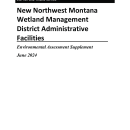Visit Us
The Northwest Montana Wetland Management District encompasses units in the Mission, Flathead, and Swan Valleys located in northwest Montana. Starting north of the Canadian border and ends close to modern day Missoula, Montana. This intermountain region was formed by glaciers during past ice ages and was once filled with ice that slowly pushed south. As the glaciers melted, scattered lakes and ponds were left behind throughout theses Valleys. Although many of these glacial lakes and ponds with their corresponding uplands have since been ditched and drained, some still remain providing important habitat for migrating and nesting waterfowl as well as other water and shore birds.
Location and Contact Information
- Northwest Montana Wetland Management DistrictView DetailsC/O Northwest Montana Wetland Management District PO Box 547 Ronan, MT 59864
About Us
Northwest Montana Wetland Management District consists of 4 National Wildlife Refuges, 15 separate Waterfowl Production Areas (WPA), and 2 conservation areas located in the Mission, Flathead, and Swan valleys.
These units include:
National Wildlife Refuges:
- Ninepipe NWR
- Pablo NWR
- Swan River NWR
- Lost Trail NWR
Waterfowl Production Areas:
- Anderson WPA
- Batavia WPA,
- Blasdel WPA
- Cruz WPA
- Crow WPA
- Duck Haven WPA
- Ereaux WPA
- Flathead WPA
- Herak WPA
- Johnson 80 WPA
- McGregor Meadows WPA
- Kicking Horse WPA
- Smith Lake WPA
- Montgomery WPA
- Sandsmark WPA
Conservation Areas:
- Lost Trail Conservation Area
- Swan Valley Conservation Area
The U.S. Fish and Wildlife Service manages an unparalleled network of public lands and waters called the National Wildlife Refuge System. With more than 560 refuges spanning the country, this system protects iconic species and provides some of the best wildlife viewing opportunities on Earth.
Each unit of the Refuge System — whether it is a wildlife refuge, a marine national monument marine national monument
A marine national monument is an ocean area designated by a presidential proclamation under the Antiquities Act. The U.S. Fish and Wildlife Service partners with the National Oceanic and Atmospheric Administration (NOAA), state and territorial governments and others to manage marine national monuments that conserve the ocean and remote islands and atolls within the National Wildlife Refuge System.
Learn more about marine national monument , a conservation area conservation area
A conservation area or wildlife management area is a type of national wildlife refuge that consists primarily or entirely of conservation easements on private lands. These conservation easements support private landowner efforts to protect important habitat for fish and wildlife. There are 15 conservation areas and nine wildlife management areas in the National Wildlife Refuge System.
Learn more about conservation area or a waterfowl production area waterfowl production area
Waterfowl production areas are small natural wetlands and grasslands within the National Wildlife Refuge System that provide breeding, resting and nesting habitat for millions of waterfowl, shorebirds, grassland birds and other wildlife. Virtually all waterfowl production areas are in the Prairie Pothole Region states of Iowa, Minnesota, Montana, North Dakota and South Dakota.
Learn more about waterfowl production area — is established to serve a statutory purpose that targets the conservation of native species dependent on its lands and water. All activities on those acres are reviewed for compatibility with this statutory purpose.
The Refuge System deploys a host of scientifically sound management tools to address biological challenges. These tools, which range from active water management to wilderness character monitoring, all are aimed at ensuring a balanced conservation approach that enables wildlife and people to thrive.
The National Wildlife Refuge System includes several thousand Waterfowl Production Areas (WPAs) that preserve wetlands and grasslands critical to waterfowl and other wildlife. Providing vital breeding and nesting habitat to millions of waterfowl and other water dependent birds, these small depressions or wetlands, bordered by wetland grasses and other wetland plants are filled with life. Some wetlands contain permanent water bodies and others are more seasonal. Both of these types of wetlands are important for wildlife.
WPAs are vital waterfowl breeding habitats that were created by an amendment to the Federal Duck Stamp Act in 1958 and are an important tool for wetland conservation. Ninety-eight cents out of every dollar generated by the sales of Federal Duck Stamps goes directly to the purchase or lease of wetland habitat for protection within the National Wildlife Refuge System. The Federal Duck Stamp Program has been called one of the most successful conservation programs ever initiated and is a highly effective way to conserve America’s natural resources.
Northwest Montana Wetland Management District provides wetland areas needed by waterfowl in the spring and summer for nesting and feeding. Thousands of waterfowl also use these wetlands in the spring and fall for feeding and resting during their long migratory flights. Primary objectives of the Northwest Montana Wetland Management District Flathead County are wetland habitat preservation and improvement, waterfowl and wildlife production, maintenance of migration habitat, and provision of winter cover for resident wildlife.
Our Library
Documents relevant to planning and programs at the Northwest Montana Wetland Management District can be found within this library.




















